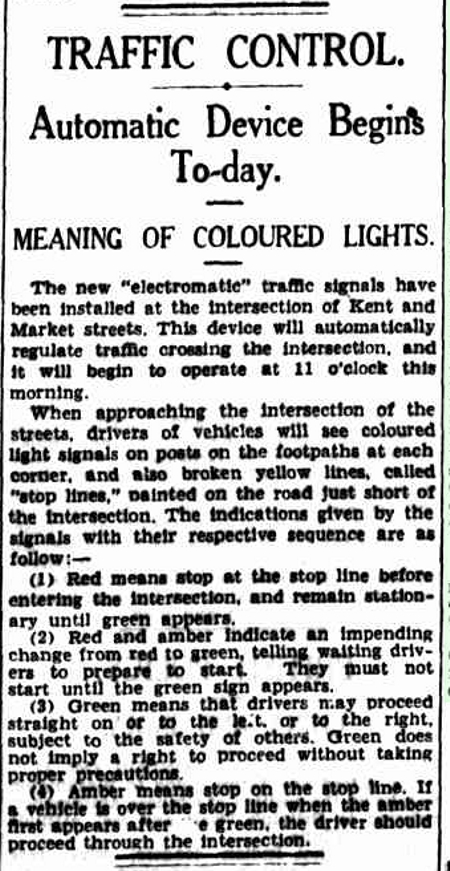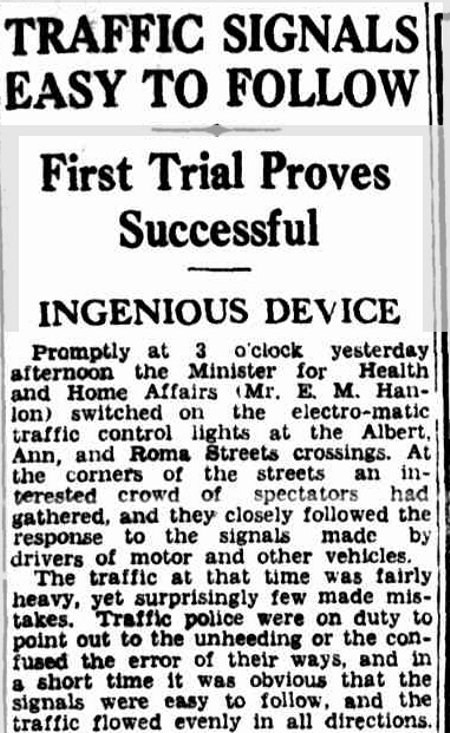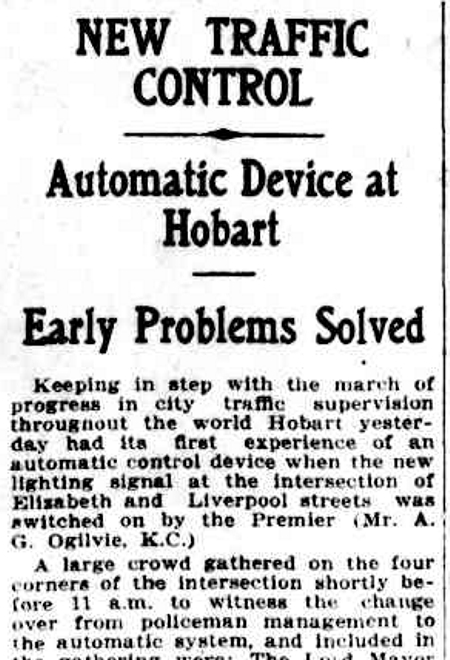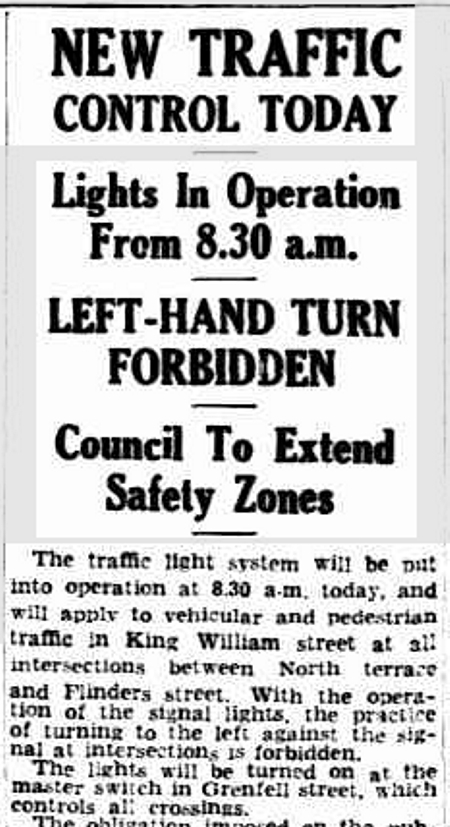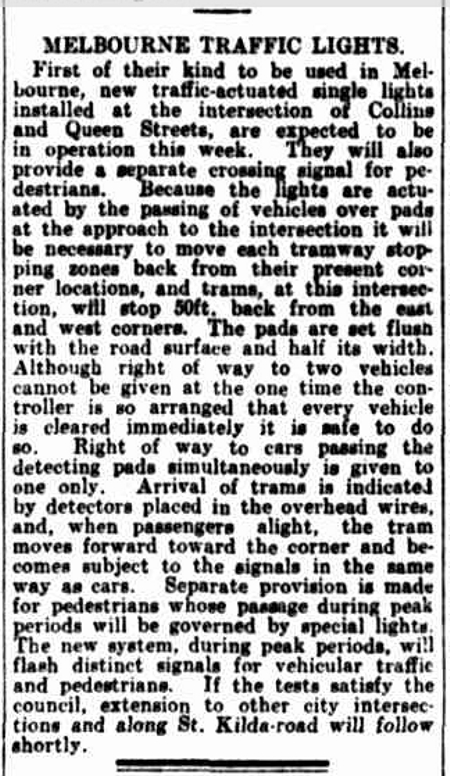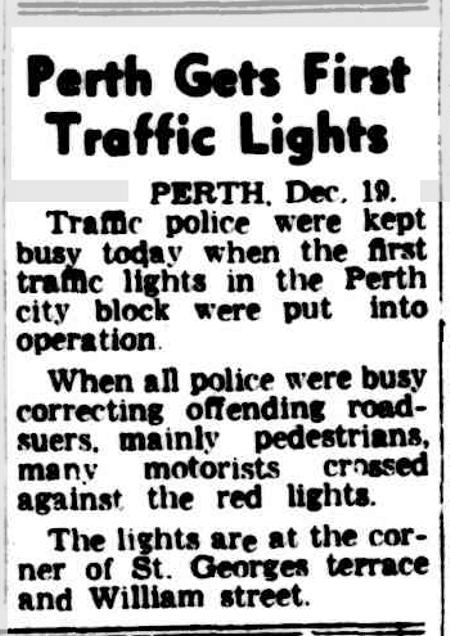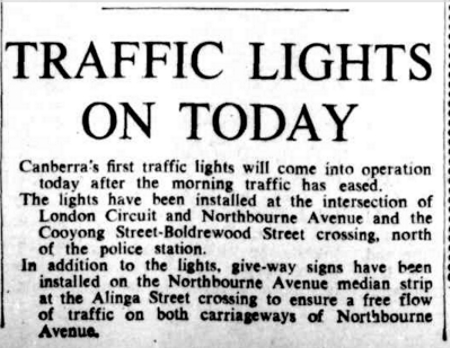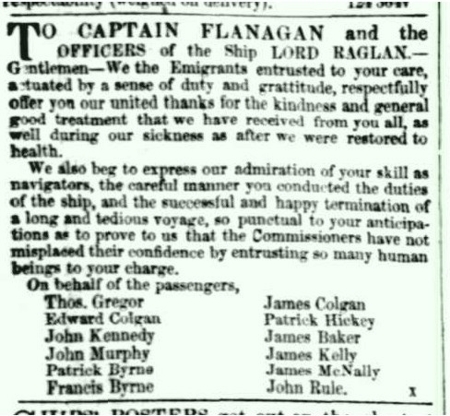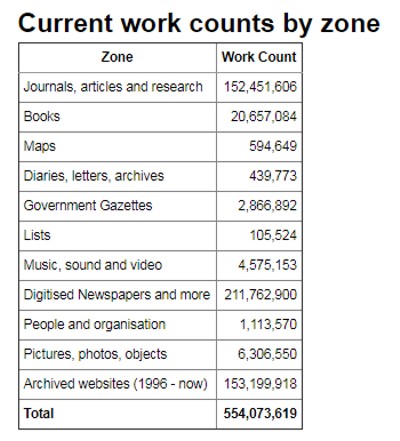The First Traffic Lights in Australia
When were the first traffic lights installed in Australia? It’s an interesting question, and one that once asked, makes you intrigued to find out … well it did me anyway.
So that’s what today’s history lesson is all about. When were the first traffic lights installed in each of the Australian states?
Of course I headed to the one and only magnificent Trove to find out, and you might just be as surprised as I was!
SYDNEY – 13 October 1933
Friday, 13 October 1933 was when Sydney’s (and Australia’s) first traffic lights began operating. The lights were installed at the intersection of Market and Kent Streets in city of Sydney, and were switched on at 11am, by the then Minister for Transport, Colonel Michael Bruxner. You can see a fabulous photo of the traffic lights here.
BRISBANE – 21 January 1936
At 3pm on Tuesday, 21 January 1936 a large crowd gathered in the CBD to watch the switching on of the first traffic lights in Brisbane. These were installed at the intersection of Ann, Upper Albert and Roma Streets.
HOBART – 27 January 1937
This one surprised me as I never realised that Hobart had traffic lights so early. But the newspapers reported the grand occasion which you can read on the link below. Just before 11am on Wednesday the 27th of January 1937 the lights were turned on at the intersection of Elizabeth and Liverpool streets.
ADELAIDE – 13 April 1937
Tuesday, 13 April 1937 was Adelaide’s big day, as that’s when Adelaide’s first traffic lights were turned on. These were installed at various intersections along King William Street in the city.
MELBOURNE – late December 1937
The Melbourne public had to adapt to traffic lights around Christmas time in 1937. The “new traffic-actuated single lights” were installed at the intersection of Collins and Queen Streets in Melbourne’s CDB, and “they will also provide a separate crossing signal for pedestrians”. As these were deemed a success others at St Kilda Road followed shortly afterwards.
PERTH – 19 December 1954
December was the time for yet another set of traffic lights to be turned on. This time it was Perth. Their first set of traffic lights was installed at the St Georges Terrace and William Street intersection.
CANBERRA – 23 October 1965
Canberra’s first two sets of traffic lights were brought into operation on Saturday, the 23rd of October 1965. The traffic lights were installed at the intersection of Northbourne Avenue and London Circuit, and Northbourne Avenue and Cooyong Street.
DARWIN – approx 1960s-1970s
I was unable to find an official date, but I did find a reference in someone’s memories of life in Darwin which says “there were no traffic lights anywhere at the time. The first set of traffic lights I remember were at the intersection of Bagot Road with the Stuart Highway!” You can read the full article here. If anyone can provide a date please let me know, and I’ll be happy to update my post.
A Thankyou to the Captain
As an avid Trovite, I love reading the old newspapers (as so many of us do). And yet, I am still amazed at the very cool stuff you can find in the old newspapers.
Take for instance one of my recent finds. A friend asked me to see what I could find on the “Lord Raglan” 1854 voyage to South Australia.
So after some general Googling to find out the basic details (the ship left Plymouth, Devon 16 July 1854, and arrived in Port Adelaide, South Australia on 23 October 1854), I found a copy of the original passenger list on the State Library of South Australia website. I also found references to it on the Passengers in History site, and The Ships List.
Anyway so then I headed off to Trove , and I came up with a thankyou message that the passengers had written to the Captain of the Lord Raglan ship, and they put it publicly in the the newspaper. How cool is that?
It’s great to know that Captain Flanagan and his crew looked after their passengers on the long voyage to a new life.
Another newspaper entry I found relating to the Lord Raglan, quotes the following …
The fine new ship Lord Raglan, 923 tons register, Captain Flanagan, for Adelaide, and the Appoline, of 500 tons, for Melbourne, having embarked their respective complements of emigrants from the Government dept, at Plymouth, sailed on Sunday. The Lord Raglan belongs to Messrs. W. Nicholson and Sons, of Sunderland, and has been fitted up on a most excellent plan, the result of the experience of Captain Lean, R.N., the Government emigration officer in London. Among other advantages, one-third of each bed can be turned up from the sides of the ship, so as to admit of a free passage two feet wide, all round her, and thus secure an effectual means of cleansing and ventilating the vessel every day. Her emigrants, numbering 369 souls, were under the charge of Surgeon Superintendent W. Brett.
This was from the South Australian Register, 21 October 1854, pg. 2.
Note: Trovite = a person who loves hanging out on the Trove website.
Valentine’s Day is “as dead as Julius Caesar”
Valentine’s Day is just a hyped up, money making day. There I said it!!
[Note: that is entirely my personal opinion here. No offence to those who love the day, but I feel why have ‘a’ day when you’re simply ‘expected’ to give something, when it’s so much nicer to receive an ‘out-of-the-blue-no-reason-needed’ gift.]
Flowers, chocolates, jewellery, a card and/or other romantic gifts … it is what you ‘should’ give your loved one right? Not necessarily. But it is certainly what we’ve been programmed to think.
Anyway it certainly wasn’t always the case. In fact in the early 1900s Valentines Day had all but died out. That sure has changed!!
ST. VALENTINE’S DAY.
Wednesday was St. Valentine’s Day, but perhaps few people knew it outside of those who are diligent students of their calendars. The old practice of sending valentines has almost if not completely died out. A leading bookseller reports that it is as “dead as Julius Caesar;” that most stationers do not stock valentines nowadays; and, moreover, that people never ask for them. The circulating of extraordinary caricatures is now almost entirely in the hands of the satirical papers, and if a remarkable event were to happen on February 14 there is a probability of St. Valentine’s Day not even being remembered by tie publishers of calendars.
But as the years went by, the tradition was starting to gain a foothold again., and according to the Albury Banner and Wodonga Express from Friday 11 July 1919 we can blame the Americans for it!
VANISHING VALENTINES.
Although the custom of sending valentines is very nearly dead in England, it may, perhaps, be revived by the American soldiers over here, for St. Valentine’s Day is much more popular in America than on this side of the water. There dainty valentines are sold for a dollar each, and, some of the more elaborate ones are sold for fifty dollars about ten pounds.
By 1939 Valentine’s Day was indeed ‘being revived’. The Mudgee Guardian and North-Western Representative newspaper from Thursday 16 February 1939 reports the following …
ST. VALENTINE’S DAY
The feast of St. Valentine, a Roman priest who was martyred under Claudius II. during the persecution in 270, was celebrated on Tuesday, February 14, by the sending of valentines and other tokens of remembrance or affection. This observance of St. Valentine’s Day appeared to be dying but has recently been revived, and several local residents on Tuesday received little tokens In honor of this quaint and ancient custom.
So Happy Valentine’s Day everyone, but remember there are 364 other days that you can show your love appreciation for the special person in your life as well.
Trove – Eight Years of Incredible Discoveries
Eight years ago, the way of historical and genealogical research in Australia changed forever. Trove went live.
Created by the National Library of Australia, the Trove website is a portal to their absolutely incredible collection of records.
By “absolutely incredible”, I’m talking millions of records. But not “just” millions. How about 554,000,000 of them? That’s right, over HALF A BILLION of them in fact! All online and all free to search. So how lucky are we?
There’s no doubt that Trove is Australia’s number 1 website for research. If it’s not yours, it should be! So go and bookmark it www.trove.nla.gov.au now.
If you’re not familiar with Trove, take a quick look at the videos below that give you a quick overview, of what it is, and the different facets to it.
So you’ll find photos, journals and articles, archived websites, government gazettes, music, sound and video recordings, diaries and letters, maps and books, even vintage issues of the Women’s Weekly magazine. They all make up the phenomenal collection of Australian history that the National Library of Australian (NLA) looks after. For more a detailed analysis on using Trove and all it’s facets, check out Shauna Hicks’ “Trove: Discover Genealogy Treasure in the National Library of Australia“.
However what most researchers (myself included) head to Trove for, is their historical newspaper collection. And why wouldn’t we, they are so fun. And with over 200 million pages of old newspaper online already – there are so many stories just waiting to be found.
The blog theme “Trove Tuesday” was started back in 2012 by Amy Houston of the Branches Leaves and Pollen blog, [note, I know the link has changed, but I still wanted to give her the credit], and through its creation, has inspired so many to find and share their amazing discoveries using Trove.
Just having a quick look through my own Trove Tuesday posts, and I’ve done articles on obituaries, the opening of a butter factory, drink ‘driving’, a hanging, a duel, several WW1 and WW2 related entries, local football match, Adelaide’s water supply, gold, South Australian pioneers, an earthquake, Christmas, the plague, a sudden death, a ploughing match … and so much more.
None of this would have been easily accessible without the online newspapers on Trove. The detail in a newspaper article is often better than you’ll find anywhere else , so it is a valuable source of information.
So I wish to say a huge CONGRATULATIONS to the National Library of Australia team for Trove’s 8th birthday, and THANKYOU, THANKYOU, THANKYOU for giving us the present of Trove.
And one last note, if you come across the following terms, here are their definitions:
– BT – before Trove
– pre-Trove – life before Trove
– post-Trove – life after Trove went live
– Troveite – a person addicted to searching Trove’s newspapers
and for even more Trove related lingo, be sure to check out a heap more at Carmel’s Library Currents blog
Related Articles:
13 Tips For Searching Trove’s Historical Newspapers

